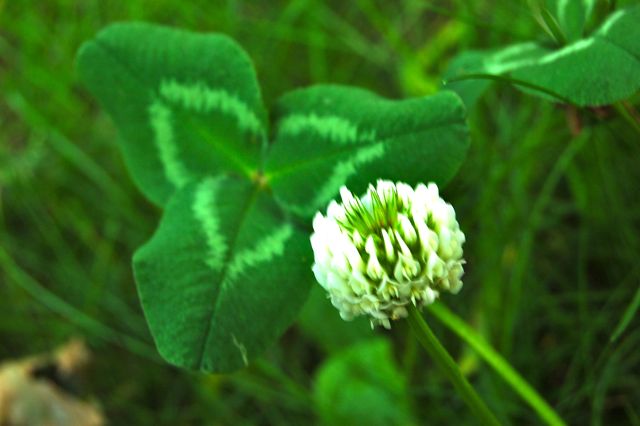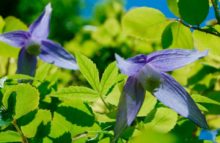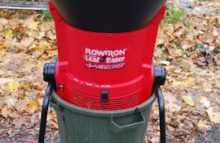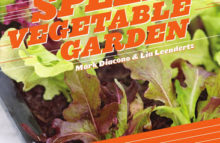Grass seed likes to germinate when the soil is warm (about 15˚C or 60˚F) but the air is cool. Warm soil encourages strong root growth, while the cool air keeps the tops from over-growth. That’s why spring (April-June) is the second-best time to sew a lawn. In Toronto, August-September are the sweetest months.
However, spring is often when we are most motivated to do things in the garden. So here are a few secrets to successful lawn getting — or fixing.
[Edited comment: I should first say that this post no way endorses the planting of lawns. If you could see mine you would laugh at the audacity of my giving lawn advice to anyone. I rarely fertilize, and then only with “organics,” and hardly ever cut the grass! However, when I was a Master Gardener, many many people had lawn questions. So, in that spirit…]
First, choose the right seed for your garden.
Is it high traffic or seldom walked-on? Sun or shade? Moist or dry? And how fanatical are you about mowing or lawn aesthetics.
For example, Kentucky blue grass (Poa pratensis) is a good, all-purpose lawny lawn grass — but it requires full sun. Red fescue (Festuca rubra) is ideal for dry shade and sandy, low-fertility soil, but it isn’t very tolerant of traffic. Perennial rye grass (Lolium perenne) is wear tolerant, and will take some shade. It also establishes quickly, so is useful in tricky areas such as slopes. However, it will die in winter if drainage is poor, such as on clay soils. Here’s some info Google found on selecting grass for northern lawns from the U.S. Better Lawn and Turf Institute. [Edited comment: again, not an endorsement, but they do have useful descriptions of the grass types.]
For the ecologically minded, here is a seed blend called the Eco-Lawn available from Wildflower Farm (which is on Hwy 12, west of Orillia). This sounds to me like the wonderchild of grass seed: it grows in sun or shade, tolerates drought, and never needs mowing, though you can if you must. Mind you, it’s sort of the mop-top of grasses, so might not be for those who are into creating bowling-green perfection.
Second, prepare your soil.
This doesn’t necessarily have to mean a total overhaul. You can fertilize before seeding (phosphorus, the middle number in any fertilizer, is what encourages strong root development, essential for a healthy lawn) or add sifted (as in: not-lumpy) compost. (I purchased a bag of low-number sludge pellets years ago that I am still using, though only on my tiny patch of grass.) If your soil is compacted from foot traffic, give it a scratch to loosen up the soil in the root zone.
Third, sow your seeds.
To distribute the seed evenly, mix with a filler like sand or even white clover seed. If your lawn is small, a tool like this seed spreader I got from Lee Valley makes the job easier. (It’s also handy for spreading fertilizer.)
White clover is a lovely addition to a lawn, if you aren’t a purist. It’s in the legume family, so it sets nitrogen in the soil. It also makes pretty, and pretty-smelling, white flowers. A garden Sarah and I walked by a couple of years ago had been completely sewn with clover. We’ll pop back later in the spring to see it’s it’s still going.
Fourth, firm the seeds into the soil.
One thing that people often neglect is to make a good, firm contact between the seed and the soil. Use something flat such as a board and step on it. An old-fashioned lawn roller is good for this.
Fifth, water!
Last year, with all the rain, one novice gardener nearby had beginner’s luck with their lawn-getting efforts. You do need to water until the seeds sprout and get established. A fine mist is better than a heavy spray. Water in the mornings, and keep an eye out for hot, baking weather while you’re nurturing your baby lawn.
Wildflower Farm has a great tip sheet for lawn starting. It also has a distraction-inducing selection of wildflower seeds. But that might have to suffice for another time…





3 comments
It troubles me that you’re promoting lawns. Unless it’s a naturalized, unmowed meadow type lawn, I think that it’s the most environmentally destructive thing we can do in our landscapes. Unless it’s for strictly recreational purposes, it should be left in the suburbs of the 50s.
Between the fuel and pollution from power mowers, the obsession with fertilizing (which, if not scientifically calculated will either run off into creeks and rivers or leach into ground water) and the lack of natural habitat it provides, there’s no reason to have a lawn.
As you might detect, I’m a fanatic about ridding landscapes of lawns wherever possible. Now let’s add in 77,000 serious injuries or deaths per year due to power tool injuries.
Yes, you are absolutely right! Thanks for your perspective. We have next to no lawns left in our gardens, and use push mowers for the mere wisps that we have left.
Rather than “promoting lawns” what we are trying to do is to encourage people, who are not ready to give up their lawns, to convert from a mono-culture and add clover to their lawns. Or to move to an eco friendly lawn mix that requires less mowing. It’s a start, at any rate.
Many people in our city neighborhood, have given up lawn entirely and we applaud that. We’ve got some great front-yard gardens on our street.
I had no idea the injuries from power tools were that high. It’s Shocking!
If you could see my “lawn,” Garden Wise Guy, you would say: a woman after my own green heart. However, when I was a Master Gardener, lawn questions were number one from the public. It’s hard to ask kids to play on anything else.
However, white clover or the new Eco-Lawn, which is a blend of fine fescues, seem good alternatives. And when you plant anything, you want it to grow — especially in these frugal times. No sense throwing money away, hence the how-to.
My link to the lawn and turf page was not meant as an endorsement. But they do have good info on the different grasses.